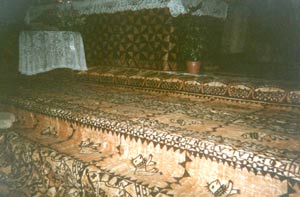 |
 |
My views on the tapa tradition The story of grandmother's tapa cloth
|
||
|
|
Marcellin College
Tapa , A Tongan Treasure
The photographers from Brother Mark's class in Lapaha
The students from Brother Mark Oliverís class at the Intermediate Department of Takuilau College used instant cameras to record the tapa making process in their home area, Lapaha. They also took some photographs inside Saint Michael's Church to show how the tapa cloth is used to decorate the church.
Photo 1: Beating the strips to make them wider and longer.
Photo 2: Strips hanging out to dry.
Photo 3: Joining the strips.
Photo 4: Hanging the tapa out to let the glue dry.
Photo 5: Painting the tapa cloth.
Photo 6: The completed tapa cloth.
Photo 7: Tapa cloth in Saint Michael's Church.
Beating the strips to make them wider and longer
Tapa is made from the bark of the tutu - the mulberry tree. The bark is first soaked in water overnight. Then the strips are beaten over a log with a wooden club until they become wider and longer. In this photograph, Malia Vake shows how to beat tapa with an ike.
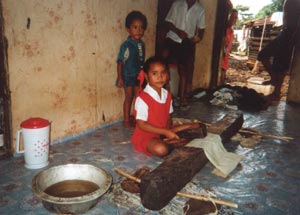
Strips hanging out to dry
After the bark has been beaten to make it wider and longer, it is hung out to dry. Hingano is showing a tapa strip which has been beaten to make it wider and longer and is now being dried.
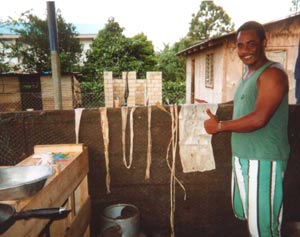
Joining the strips
In this photograph you can see how the strips are joined. This will be done using a paste made from manioke (tapioca) flour, or potato starch. The layers of cloth are then joined crosswise. The cloth is then dried again before painting. You can see it up to dry in photograph no.5.
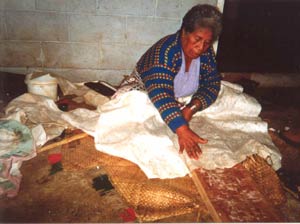
Hanging the tapa out to let the glue dry
In this photograph, Lino 'Onesi is standing in front of the newly pasted tapa cloth which was made at his home and is now hanging up to dry. When it is dry the patterns will be painted on.
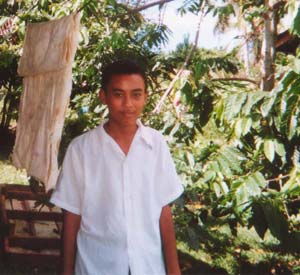
Painting the tapa cloth
The tapa cloth is laid out on the grass for painting. In this photograph, members of the Vaka family from Lapaha are painting it with black dye made from the bark and roots of the koka tree. It is a slow and difficult process to make the dye.
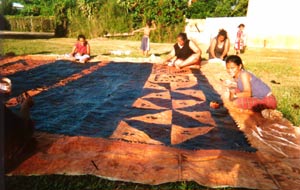
The completed tapa cloth
This is the completed tapa cloth which has been decorated with black dye. The standard length of a big cloth is 50 feet. The patterns may be personal favourites or traditional or family designs. The more dye used on the painting, the higher the value of the cloth.
Tapa cloths such as this are usually valued at $800 to $1000. A special, prize tapa may fetch $1200. This particular tapa cloth made by the Vaka family was photographed just in time, as it was sold shortly afterwards for $1200.
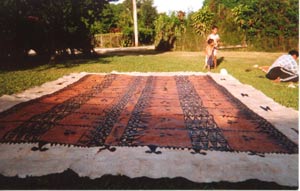
Tapa cloth in Saint Michael's Church.
In Saint Michael's Church in Lapaha, tapa is used for special occasions . It can be used as a floor covering and it is also used to cover the altar. The occasion for which the church was decorated with tapa was the feast of Corpus Christi.
